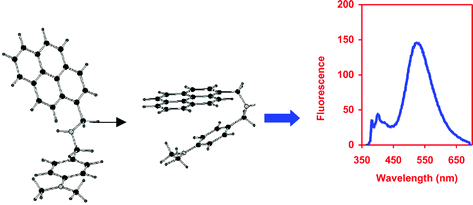Organic intramolecular exciplexes, N-(4-dimethylaminobenzyl)-N-(1-pyrenemethyl)amine (1) and N′-4-dimethylaminonaphthyl-N-(1-pyrenemethyl)amine (2), were used as model systems to reveal major factors affecting their exciplex fluorescence, and thus lay the basis for developing emissive target-assembled exciplexes for DNA-mounted systems in solution. These models with an aromatic pyrenyl hydrocarbon moiety as an electron acceptor appropriately connected to an aromatic dimethylamino electron donor component (N,N-dimethylaminophenyl or N,N-dimethylaminonaphthyl) showed strong intramolecular exciplex emission in both non-polar and highly polar solvents. The effect of dielectric constant on the maximum wavelength for exciplex emission was studied, and emission was observed for 1 and 2 over the full range of solvent from non-polar hydrocarbons up to N-methylformamide with a dielectric constant of 182. Quantum yields were determined for these intramolecular exciplexes in a range of solvents relative to that for Hoechst 33258. Conformational analysis of 1 was performed both computationally and via qualitative 2D NMR using 1H-NOESY experiments. The results obtained indicated the contribution of pre-folded conformation(s) to the ground state of 1 conducive to exciplex emission. This research provides the initial background for design of self-assembled, DNA-mounted exciplexes and underpins further development of exciplex-based hybridisation bioassays.

You have access to this article
 Please wait while we load your content...
Something went wrong. Try again?
Please wait while we load your content...
Something went wrong. Try again?


 Please wait while we load your content...
Please wait while we load your content...